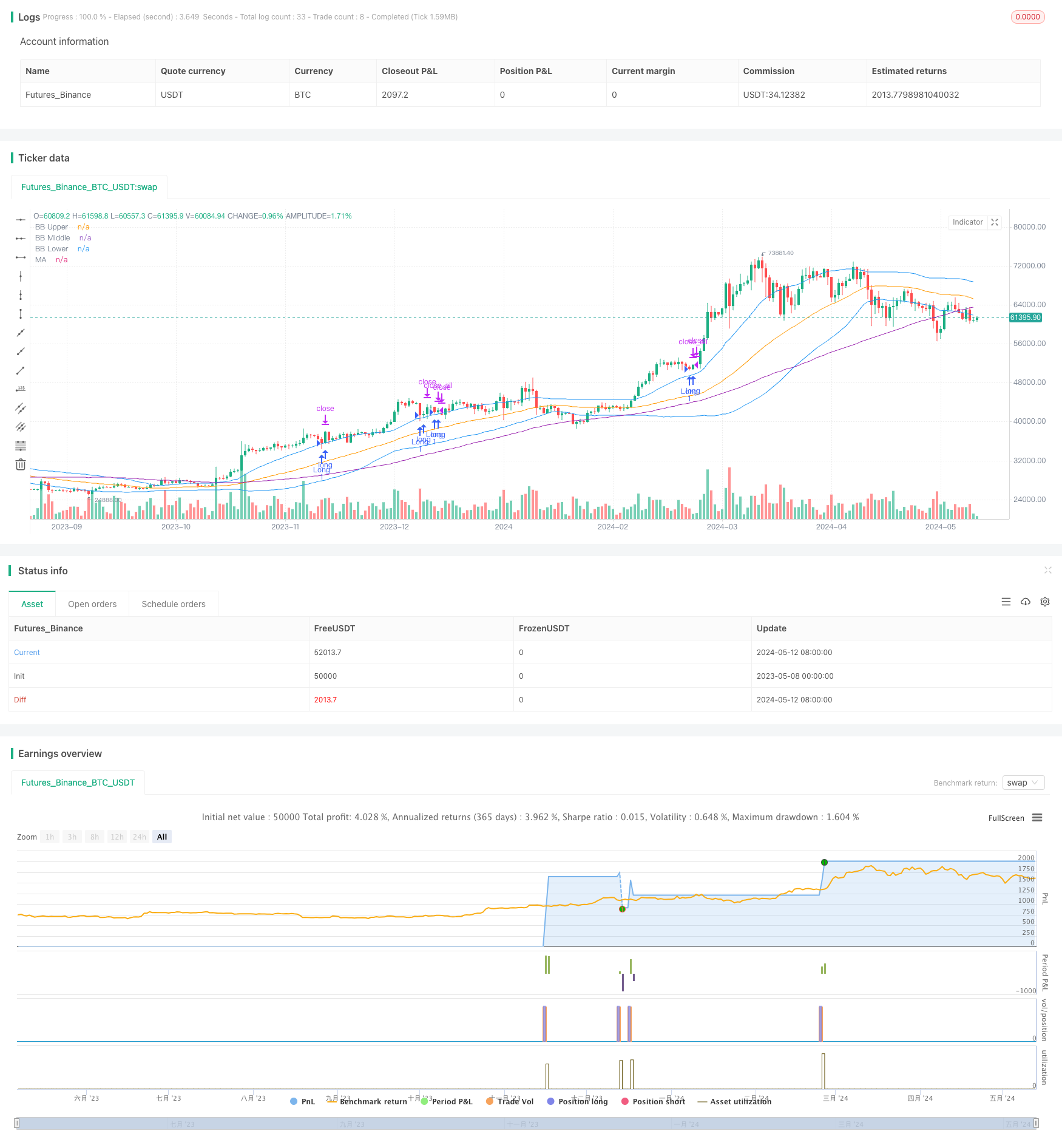
概述
该策略旨在利用布林带(BB)、移动平均线(MA)和相对强弱指数(RSI)的组合来捕捉短期价格波动,从而进行多头交易。当价格高于上轨和移动平均线,且RSI指标显示超卖状态时,策略进行多头入场。策略通过百分比止损和止盈来管理风险和锁定利润,并根据交易者的Bybit账户等级调整入场价格,以考虑佣金的影响。
策略原理
该策略基于以下原理: 1. 布林带:当价格突破上轨时,表明市场可能出现上涨趋势。 2. 移动平均线:价格高于移动平均线,说明当前处于上涨趋势。 3. 相对强弱指数:当RSI低于超卖阈值时,表明市场可能出现反转,价格可能上涨。
策略通过结合这三个指标,当价格突破布林带上轨、高于移动平均线,且RSI处于超卖区域时,认为市场可能出现上涨机会,因此进行多头入场。同时,策略设置止损和止盈价格,以控制风险和锁定利润。
策略优势
- 结合多个指标:该策略综合考虑了布林带、移动平均线和RSI,提供了更全面的市场分析。
- 趋势跟踪:通过布林带和移动平均线,策略能够识别当前的市场趋势。
- 超卖信号:利用RSI指标识别潜在的超卖情况,捕捉可能的反转机会。
- 风险管理:策略设置了基于百分比的止损和止盈,有助于控制风险和锁定利润。
- 佣金考虑:根据交易者的Bybit账户等级调整入场价格,以考虑佣金的影响。
策略风险
- 错误信号:任何技术指标都有可能产生错误信号,导致策略进行不必要的交易。
- 市场波动:短期内市场可能出现剧烈波动,导致止损被触发或错过潜在利润。
- 趋势逆转:策略假设当前趋势将持续,但实际上趋势可能突然逆转,导致损失。
- 佣金影响:虽然策略考虑了佣金,但频繁交易仍可能导致佣金成本增加,影响整体收益。
策略优化方向
- 参数优化:对布林带、移动平均线和RSI的参数进行优化,以适应不同的市场状况。
- 多空结合:可以考虑加入空头交易条件,以充分利用不同的市场机会。
- 动态止损止盈:根据市场波动性动态调整止损和止盈水平,以更好地控制风险和锁定利润。
- 组合其他指标:考虑引入其他技术指标,如MACD、ATR等,以提高策略的可靠性。
- 资金管理:优化资金管理方法,如根据风险调整头寸大小,以提高策略的风险调整后收益。
总结
该策略利用布林带、移动平均线和RSI的组合,识别短期多头交易机会。它通过布林带和移动平均线确定趋势,利用RSI识别超卖情况,并设置止损止盈以管理风险。策略考虑了佣金的影响,并根据交易者的Bybit账户等级进行调整。尽管该策略具有一定优势,但仍存在错误信号、市场波动和趋势逆转等风险。未来可以通过参数优化、多空结合、动态止损止盈、组合其他指标和优化资金管理等方向对策略进行优化,以提高其性能和适应性。
策略源码
/*backtest
start: 2023-05-08 00:00:00
end: 2024-05-13 00:00:00
period: 1d
basePeriod: 1h
exchanges: [{"eid":"Futures_Binance","currency":"BTC_USDT"}]
*/
//@BryanAaron
//@version=5
strategy("Bybit . BB Short-Term Trading Strategy - Long Only", overlay=true)
// Input parameters
bbLength = input(45, title="BB Length")
bbMultiplier = input(1.0, title="BB Multiplier")
maLength = input(90, title="MA Length")
rsiLength = input(5, title="RSI Length")
rsiUpperThreshold = input(85, title="RSI Upper Threshold")
rsiLowerThreshold = input(45, title="RSI Lower Threshold")
slPerc = input(2.0, title="Stop Loss %")
tpPerc = input(4.0, title="Take Profit %")
bybitAccountLevel = input.string("VIP 0", title="Bybit Account Level", options=["VIP 0", "VIP 1", "VIP 2", "VIP 3", "VIP 4"])
// Calculate Bollinger Bands
[bbMiddle, bbUpper, bbLower] = ta.bb(close, bbLength, bbMultiplier)
// Calculate moving average
ma = ta.sma(close, maLength)
// Calculate RSI
rsi = ta.rsi(close, rsiLength)
// Trading conditions
longCondition = close > bbUpper and close > ma and rsi < rsiLowerThreshold
shortCondition = close < bbLower and close < ma and rsi > rsiUpperThreshold
// Entry and exit signals
var bool longEntry = false
var bool shortEntry = false
if (longCondition and not longEntry)
longEntry := true
shortEntry := false
else if (shortCondition and not shortEntry)
shortEntry := true
longEntry := false
else if (not longCondition and not shortCondition)
longEntry := false
shortEntry := false
// Set commission based on Bybit account level
commissionPerc = switch bybitAccountLevel
"VIP 0" => 0.075
"VIP 1" => 0.065
"VIP 2" => 0.055
"VIP 3" => 0.045
"VIP 4" => 0.035
=> 0.075
// Adjust entry prices based on commission
longEntryPrice = close * (1 + commissionPerc / 100)
shortEntryPrice = close * (1 - commissionPerc / 100)
// Calculate stop loss and take profit prices
longStopPrice = longEntryPrice * (1 - slPerc / 100)
longProfitPrice = longEntryPrice * (1 + tpPerc / 100)
shortStopPrice = shortEntryPrice * (1 + slPerc / 100)
shortProfitPrice = shortEntryPrice * (1 - tpPerc / 100)
// Plot signals
plotshape(longEntry, title="Long Entry", location=location.belowbar, style=shape.triangleup, size=size.small, color=color.green)
plotshape(shortEntry, title="Short Entry", location=location.abovebar, style=shape.triangledown, size=size.small, color=color.red)
// Entry and exit
if (longEntry)
strategy.entry("Long", strategy.long, limit=longEntryPrice, stop=longStopPrice, comment="Long Entry")
strategy.exit("Long TP/SL", from_entry="Long", limit=longProfitPrice, stop=longStopPrice, comment="Long Exit")
else if (shortEntry)
strategy.entry("Short", strategy.short, limit=shortEntryPrice, stop=shortStopPrice, comment="Short Entry")
strategy.exit("Short TP/SL", from_entry="Short", limit=shortProfitPrice, stop=shortStopPrice, comment="Short Exit")
else
strategy.close_all(comment="Close All")
// Plot Bollinger Bands
plot(bbUpper, color=color.blue, title="BB Upper")
plot(bbMiddle, color=color.orange, title="BB Middle")
plot(bbLower, color=color.blue, title="BB Lower")
// Plot moving average
plot(ma, color=color.purple, title="MA")
相关推荐